Advertisements
Online Mock Tests
Chapters
2: Inverse Trigonometric Functions
3: Matrices
4: Determinants
5: Continuity And Differentiability
6: Application Of Derivatives
7: Integrals
8: Application Of Integrals
9: Differential Equations
10: Vector Algebra
11: Three Dimensional Geometry
▶ 12: Linear Programming
13: Probability
![NCERT Exemplar solutions for Mathematics [English] Class 12 chapter 12 - Linear Programming NCERT Exemplar solutions for Mathematics [English] Class 12 chapter 12 - Linear Programming - Shaalaa.com](/images/mathematics-english-class-12_6:5f2b1b2038084cf381bfa42c826a928c.jpg)
Advertisements
Solutions for Chapter 12: Linear Programming
Below listed, you can find solutions for Chapter 12 of CBSE NCERT Exemplar for Mathematics [English] Class 12.
NCERT Exemplar solutions for Mathematics [English] Class 12 12 Linear Programming Solved Examples [Pages 243 - 249]
Short Answer
Determine the maximum value of Z = 4x + 3y if the feasible region for an LPP is shown in figure
Determine the minimum value of Z = 3x + 2y (if any), if the feasible region for an LPP is shown in Figue.
Solve the following LPP graphically:
Maximise Z = 2x + 3y, subject to x + y ≤ 4, x ≥ 0, y ≥ 0
A manufacturing company makes two types of television sets; one is black and white and the other is colour. The company has resources to make at most 300 sets a week. It takes Rs 1800 to make a black and white set and Rs 2700 to make a coloured set. The company can spend not more than Rs 648000 a week to make television sets. If it makes a profit of Rs 510 per black and white set and Rs 675 per coloured set, how many sets of each type should be produced so that the company has maximum profit? Formulate this problem as a LPP given that the objective is to maximise the profit
Long Answer
A manufacturing company makes two types of television sets; one is black and white and the other is colour. The company has resources to make at most 300 sets a week. It takes Rs 1800 to make a black and white set and Rs 2700 to make a coloured set. The company can spend not more than Rs 648000 a week to make television sets. If it makes a profit of Rs 510 per black and white set and Rs 675 per coloured set, how many sets of each type should be produced so that the company has maximum profit? Formulate this problem as a LPP given that the objective is to maximise the profit.
Minimise Z = 3x + 5y subject to the constraints:
x + 2y ≥ 10
x + y ≥ 6
3x + y ≥ 8
x, y ≥ 0
Objective Type Questions
The corner points of the feasible region determined by the system of linear constraints are (0, 10), (5, 5), (15, 15), (0, 20). Let Z = px + qy, where p, q > 0. Condition on p and q so that the maximum of Z occurs at both the points (15, 15) and (0, 20) is ______.
p = q
p = 2q
q = 2p
q = 3p
Feasible region (shaded) for a LPP is shown in the Figure Minimum of Z = 4x + 3y occurs at the point ______.
(0, 8)
(2, 5)
(4, 3)
(9, 0)
Fill in the blanks 9 to 10
In a LPP, the linear function which has to be maximised or minimised is called a linear ______ function.
The common region determined by all the linear constraints of a LPP is called the ______ region.
If the feasible region for a linear programming problem is bounded, then the objective function Z = ax + by has both a maximum and a minimum value on R.
True
False
The minimum value of the objective function Z = ax + by in a linear programming problem always occurs at only one corner point of the feasible region
True
False
NCERT Exemplar solutions for Mathematics [English] Class 12 12 Linear Programming Exercise [Pages 250 - 257]
Short Answer
Determine the maximum value of Z = 11x + 7y subject to the constraints : 2x + y ≤ 6, x ≤ 2, x ≥ 0, y ≥ 0.
Maximise Z = 3x + 4y, subject to the constraints: x + y ≤ 1, x ≥ 0, y ≥ 0
Maximise the function Z = 11x + 7y, subject to the constraints: x ≤ 3, y ≤ 2, x ≥ 0, y ≥ 0.
Minimise Z = 13x – 15y subject to the constraints: x + y ≤ 7, 2x – 3y + 6 ≥ 0, x ≥ 0, y ≥ 0
Determine the maximum value of Z = 3x + 4y if the feasible region (shaded) for a LPP is shown in Figure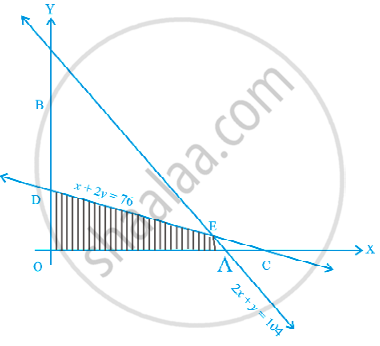
Feasible region (shaded) for a LPP is shown in Figure. Maximise Z = 5x + 7y.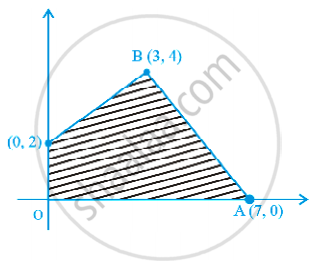
The feasible region for a LPP is shown in Figure. Find the minimum value of Z = 11x + 7y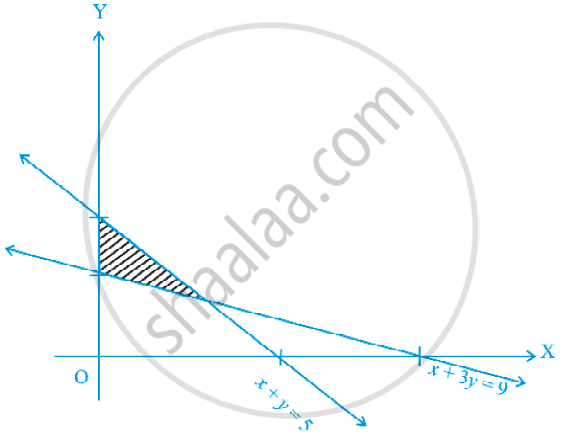
Refer to Exercise 7 above. Find the maximum value of Z.
The feasible region for a LPP is shown in figure. Evaluate Z = 4x + y at each of the corner points of this region. Find the minimum value of Z, if it exists.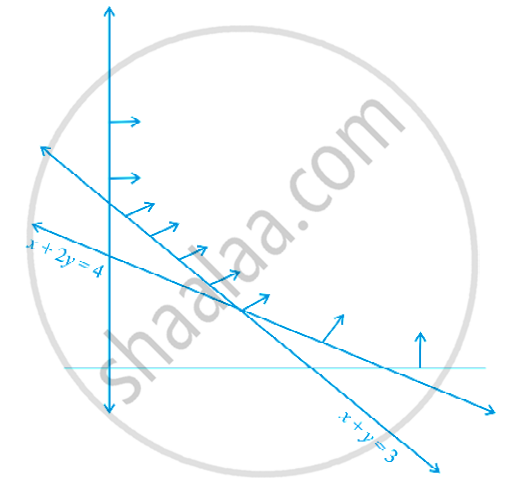
In figure, the feasible region (shaded) for a LPP is shown. Determine the maximum and minimum value of Z = x + 2y.
A manufacturer of electronic circuits has a stock of 200 resistors, 120 transistors and 150 capacitors and is required to produce two types of circuits A and B. Type A requires 20 resistors, 10 transistors and 10 capacitors. Type B requires 10 resistors, 20 transistors and 30 capacitors. If the profit on type A circuit is Rs 50 and that on type B circuit is Rs 60, formulate this problem as a LPP so that the manufacturer can maximise his profit.
A firm has to transport 1200 packages using large vans which can carry 200 packages each and small vans which can take 80 packages each. The cost for engaging each large van is Rs 400 and each small van is Rs 200. Not more than Rs 3000 is to be spent on the job and the number of large vans can not exceed the number of small vans. Formulate this problem as a LPP given that the objective is to minimise cost.
A company manufactures two types of screws A and B. All the screws have to pass through a threading machine and a slotting machine. A box of Type A screws requires 2 minutes on the threading machine and 3 minutes on the slotting machine. A box of type B screws requires 8 minutes of threading on the threading machine and 2 minutes on the slotting machine. In a week, each machine is available for 60 hours. On selling these screws, the company gets a profit of Rs 100 per box on type A screws and Rs 170 per box on type B screws. Formulate this problem as a LPP given that the objective is to maximise profit.
A company manufactures two types of sweaters : type A and type B. It costs Rs 360 to make a type A sweater and Rs 120 to make a type B sweater. The company can make at most 300 sweaters and spend at most Rs 72000 a day. The number of sweaters of type B cannot exceed the number of sweaters of type A by more than 100. The company makes a profit of Rs 200 for each sweater of type A and Rs 120 for every sweater of type B.
Formulate this problem as a LPP to maximise the profit to the company.
A man rides his motorcycle at the speed of 50 km/hour. He has to spend Rs 2 per km on petrol. If he rides it at a faster speed of 80 km/hour, the petrol cost increases to Rs 3 per km. He has atmost Rs 120 to spend on petrol and one hour’s time. He wishes to find the maximum distance that he can travel. Express this problem as a linear programming problem
Long Answer
Refer to question 11. How many of circuits of Type A and of Type B, should be produced by the manufacturer so as to maximise his profit? Determine the maximum profit.
Refer to quastion 12. What will be the minimum cost?
Refer to question 13. Solve the linear programming problem and determine the maximum profit to the manufacturer
Refer to question 14. How many sweaters of each type should the company make in a day to get a maximum profit? What is the maximum profit.
Refer to question 15. Determine the maximum distance that the man can travel.
Refer to question 15. Determine the maximum distance that the man can travel.
Maximise Z = x + y subject to x + 4y ≤ 8, 2x + 3y ≤ 12, 3x + y ≤ 9, x ≥ 0, y ≥ 0.
A manufacturer produces two Models of bikes-Model X and Model Y. Model X takes a 6 man-hours to make per unit, while Model Y takes 10 man-hours per unit. There is a total of 450 man-hour available per week. Handling and Marketing costs are Rs 2000 and Rs 1000 per unit for Models X and Y respectively. The total funds available for these purposes are Rs 80,000 per week. Profits per unit for Models X and Y are Rs 1000 and Rs 500, respectively. How many bikes of each model should the manufacturer produce so as to yield a maximum profit? Find the maximum profit.
In order to supplement daily diet, a person wishes to take some X and some wishes Y tablets. The contents of iron, calcium and vitamins in X and Y (in milligrams per tablet) are given as below:
| Tablets | Iron | Calcium | Vitamin |
| X | 6 | 3 | 2 |
| Y | 2 | 3 | 4 |
The person needs atleast 18 milligrams of iron, 21 milligrams of calcium and 16 milligrams of vitamin. The price of each tablet of X and Y is Rs 2 and Rs 1 respectively. How many tablets of each should the person take in order to satisfy the above requirement at the minimum cost?
A company makes 3 model of calculators: A, B and C at factory I and factory II. The company has orders for at least 6400 calculators of model A, 4000 calculator of model B and 4800 calculator of model C. At factory I, 50 calculators of model A, 50 of model B and 30 of model C are made every day; at factory II, 40 calculators of model A, 20 of model B and 40 of model C are made everyday. It costs Rs 12000 and Rs 15000 each day to operate factory I and II, respectively. Find the number of days each factory should operate to minimise the operating costs and still meet the demand.
Maximise and Minimise Z = 3x – 4y subject to x – 2y ≤ 0, – 3x + y ≤ 4, x – y ≤ 6, x, y ≥ 0
Objective Type Questions from 26 to 34
The corner points of the feasible region determined by the system of linear constraints are (0, 0), (0, 40), (20, 40), (60, 20), (60, 0). The objective function is Z = 4x + 3y ______.
Compare the quantity in Column A and Column B
| Column A | Column B |
| Maximum of Z | 325 |
The quantity in column A is greater
The quantity in column B is greater
The two quantities are equal
The relationship can not be determined on the basis of the information supplied
The feasible solution for a LPP is shown in Figure. Let Z = 3x – 4y be the objective function. Minimum of Z occurs at ______.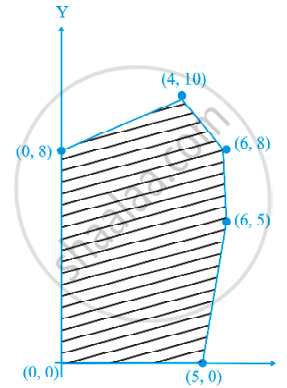
(0, 0)
(0, 8)
(5, 0)
(4, 10)
Refer to Question 27. Maximum of Z occurs at ______.
(5, 0)
(6, 5)
(6, 8)
(4, 10)
Refer to Question 27. (Maximum value of Z + Minimum value of Z) is equal to ______.
13
1
– 13
– 17
The feasible region for an LPP is shown in the figure. Let F = 3x – 4y be the objective function. Maximum value of F is ______.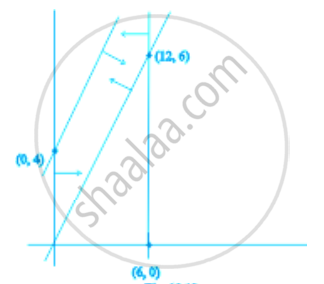
0
8
12
– 18
Refer to Question 30. Minimum value of F is ______.
0
– 16
12
Does not exist
Corner points of the feasible region for an LPP are (0, 2), (3, 0), (6, 0), (6, 8) and (0, 5). Let F = 4x + 6y be the objective function. The Minimum value of F occurs at ______.
(0, 2) only
(3, 0) only
The midpoint of the line segment joining the points (0, 2) and (3, 0) only
Any point on the line segment joining the points (0, 2) and (3, 0).
Refer to Question 32, Maximum of F – Minimum of F = ______.
60
48
42
18
Corner points of the feasible region determined by the system of linear constraints are (0, 3), (1, 1) and (3, 0). Let Z = px + qy, where p, q > 0. Condition on p and q so that the minimum of Z occurs at (3, 0) and (1, 1) is ______.
p = 2q
p = `"q"/2`
p = 3q
p = q
Fill in the blanks 35 to 41
In a LPP, the linear inequalities or restrictions on the variables are called ____________.
In a LPP, the objective function is always ______.
If the feasible region for a LPP is ______ then the optimal value of the objective function Z = ax + by may or may not exist.
In a LPP if the objective function Z = ax + by has the same maximum value on two corner points of the feasible region, then every point on the line segment joining these two points give the same ______ value.
A feasible region of a system of linear inequalities is said to be ______ if it can be enclosed within a circle.
A corner point of a feasible region is a point in the region which is the ______ of two boundary lines.
The feasible region for an LPP is always a ______ polygon.
State whether the following statement is True or False: 42 to 45
If the feasible region for a LPP is unbounded, maximum or minimum of the objective function Z = ax + by may or may not exist.
True
False
Maximum value of the objective function Z = ax + by in a LPP always occurs at only one corner point of the feasible region.
True
False
In a LPP, the minimum value of the objective function Z = ax + by is always 0 if the origin is one of the corner point of the feasible region.
False
True
In a LPP, the maximum value of the objective function Z = ax + by is always finite.
True
False
Solutions for 12: Linear Programming
![NCERT Exemplar solutions for Mathematics [English] Class 12 chapter 12 - Linear Programming NCERT Exemplar solutions for Mathematics [English] Class 12 chapter 12 - Linear Programming - Shaalaa.com](/images/mathematics-english-class-12_6:5f2b1b2038084cf381bfa42c826a928c.jpg)
NCERT Exemplar solutions for Mathematics [English] Class 12 chapter 12 - Linear Programming
Shaalaa.com has the CBSE Mathematics Mathematics [English] Class 12 CBSE solutions in a manner that help students grasp basic concepts better and faster. The detailed, step-by-step solutions will help you understand the concepts better and clarify any confusion. NCERT Exemplar solutions for Mathematics Mathematics [English] Class 12 CBSE 12 (Linear Programming) include all questions with answers and detailed explanations. This will clear students' doubts about questions and improve their application skills while preparing for board exams.
Further, we at Shaalaa.com provide such solutions so students can prepare for written exams. NCERT Exemplar textbook solutions can be a core help for self-study and provide excellent self-help guidance for students.
Concepts covered in Mathematics [English] Class 12 chapter 12 Linear Programming are Introduction of Linear Programming, Mathematical Formulation of Linear Programming Problem, Different Types of Linear Programming Problems, Graphical Method of Solving Linear Programming Problems, Linear Programming Problem and Its Mathematical Formulation.
Using NCERT Exemplar Mathematics [English] Class 12 solutions Linear Programming exercise by students is an easy way to prepare for the exams, as they involve solutions arranged chapter-wise and also page-wise. The questions involved in NCERT Exemplar Solutions are essential questions that can be asked in the final exam. Maximum CBSE Mathematics [English] Class 12 students prefer NCERT Exemplar Textbook Solutions to score more in exams.
Get the free view of Chapter 12, Linear Programming Mathematics [English] Class 12 additional questions for Mathematics Mathematics [English] Class 12 CBSE, and you can use Shaalaa.com to keep it handy for your exam preparation.
